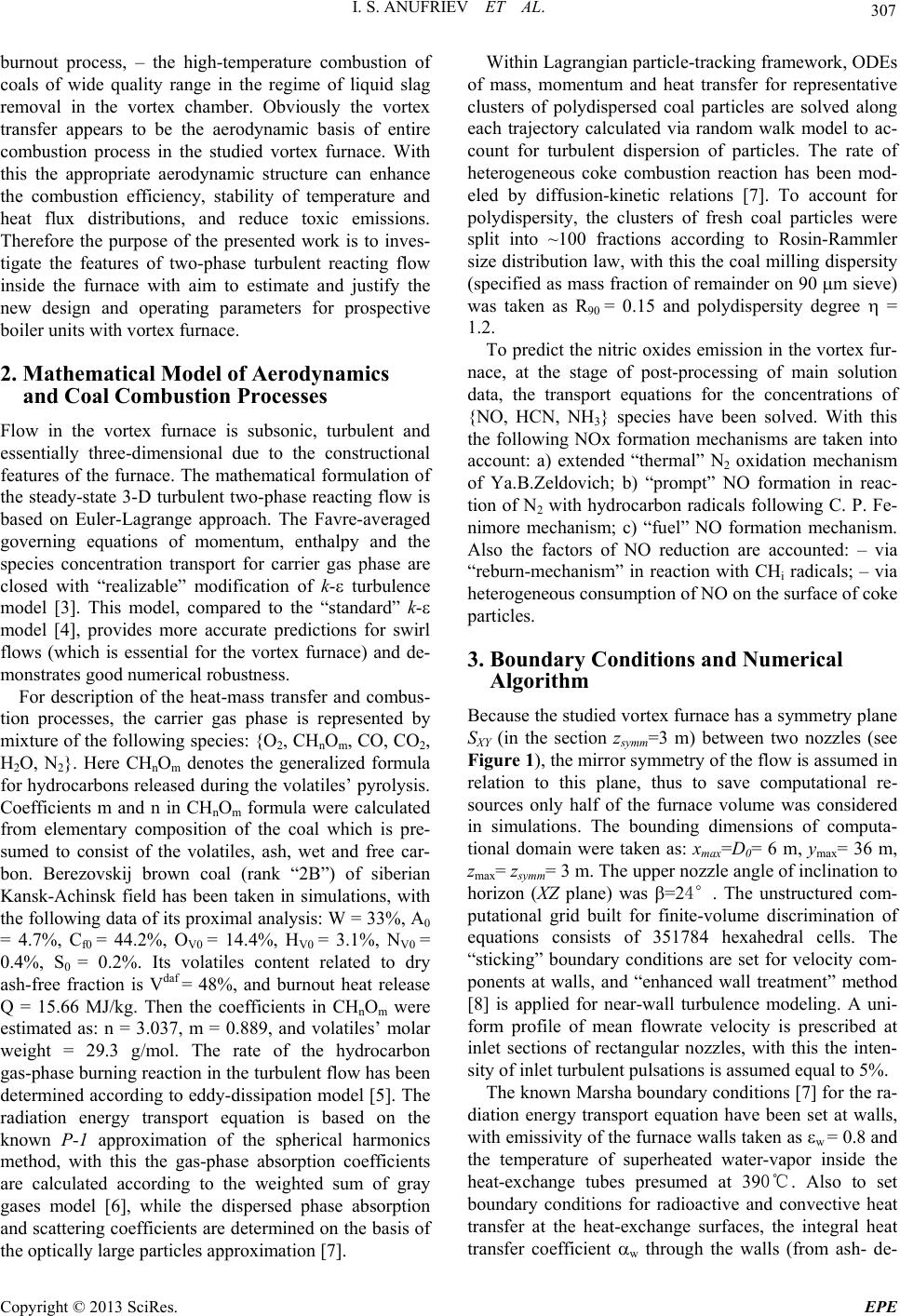
I. S. ANUFRIEV ET AL. 307
burnout process, – the high-temperature combustion of
coals of wide quality range in the regime of liquid slag
removal in the vortex chamber. Obviously the vortex
transfer appears to be the aerodynamic basis of entire
combustion process in the studied vortex furnace. With
this the appropriate aerodynamic structure can enhance
the combustion efficiency, stability of temperature and
heat flux distributions, and reduce toxic emissions.
Therefore the purpose of the presented work is to inves-
tigate the features of two-phase turbulent reacting flow
inside the furnace with aim to estimate and justify the
new design and operating parameters for prospective
boiler units with vortex furnace.
2. Mathematical Model of Aerodynamics
and Coal Combustion Processes
Flow in the vortex furnace is subsonic, turbulent and
essentially three-dimensional due to the constructional
features of the furnace. The mathematical formulation of
the steady-state 3-D turbulent two-phase reacting flow is
based on Euler-Lagrange approach. The Favre-averaged
governing equations of momentum, enthalpy and the
species concentration transport for carrier gas phase are
closed with “realizable” modification of k- turbulence
model [3]. This model, compared to the “standard” k-
model [4], provides more accurate predictions for swirl
flows (which is essential for the vortex furnace) and de-
monstrates good numerical robustness.
For description of the heat-mass transfer and combus-
tion processes, the carrier gas phase is represented by
mixture of the following sp ecies: {O2, CHnOm, CO, CO2,
H2O, N2}. Here CHnOm denotes the generalized formula
for hydrocarbons released during the volatiles’ pyro lysis.
Coefficients m and n in CHnOm formula were calculated
from elementary composition of the coal which is pre-
sumed to consist of the volatiles, ash, wet and free car-
bon. Berezovskij brown coal (rank “2B”) of siberian
Kansk-Achinsk field has been taken in simulations, with
the following data of its proximal analysis: W = 33 %, A0
= 4.7%, Cf0 = 44.2%, OV0 = 14.4%, HV0 = 3.1%, NV0 =
0.4%, S0 = 0.2%. Its volatiles content related to dry
ash-free fraction is Vdaf = 48%, and burnout heat release
Q = 15.66 MJ/kg. Then the coefficients in CHnOm were
estimated as: n = 3.037, m = 0.889, and volatiles’ molar
weight = 29.3 g/mol. The rate of the hydrocarbon
gas-phase burning reaction in the turbulent flow has been
determined according to eddy-dissipation model [5]. The
radiation energy transport equation is based on the
known P-1 approximation of the spherical harmonics
method, with this the gas-phase absorption coefficients
are calculated according to the weighted sum of gray
gases model [6], while the dispersed phase absorption
and scattering coefficients are determined on the basis of
the optically large particles approximatio n [7].
Within Lagrangian particle-tracking framework, ODEs
of mass, momentum and heat transfer for representative
clusters of polydispersed coal particles are solved along
each trajectory calculated via random walk model to ac-
count for turbulent dispersion of particles. The rate of
heterogeneous coke combustion reaction has been mod-
eled by diffusion-kinetic relations [7]. To account for
polydispersity, the clusters of fresh coal particles were
split into ~100 fractions according to Rosin-Rammler
size distribution law, with this the co al milling dispersity
(specified as mass fraction of remainder on 90 m sieve)
was taken as R90 = 0.15 and polydispersity degree =
1.2.
To predict the nitric oxides emission in the vortex fur-
nace, at the stage of post-processing of main solution
data, the transport equations for the concentrations of
{NO, HCN, NH3} species have been solved. With this
the following NOx formation mechanisms are taken into
account: a) extended “thermal” N2 oxidation mechanism
of Ya.B.Zeldovich; b) “prompt” NO formation in reac-
tion of N2 with hydrocarbon radicals following C. P. Fe-
nimore mechanism; c) “fuel” NO formation mechanism.
Also the factors of NO reduction are accounted: – via
“reburn-mechanism” in reaction with CHi radicals; – via
heterogeneous consumption of NO on the surface of coke
particles.
3. Boundary Conditions and Numerical
Algorithm
Because the studied vortex furnace has a symmetry plane
SXY (in the section zsymm=3 m) between two nozzles (see
Figure 1), the mirror symmetry of the flow is assumed in
relation to this plane, thus to save computational re-
sources only half of the furnace volume was considered
in simulations. The bounding dimensions of computa-
tional domain were taken as: xmax=D0= 6 m, ymax= 36 m,
zmax= zsymm= 3 m. The upper nozzle angle of inclination to
horizon (XZ plane) was =24°. The unstructured com-
putational grid built for finite-volume discrimination of
equations consists of 351784 hexahedral cells. The
“sticking” boundary conditions are set for velocity com-
ponents at walls, and “enhanced wall treatment” method
[8] is applied for near-wall turbulence modeling. A uni-
form profile of mean flowrate velocity is prescribed at
inlet sections of rectangular nozzles, with this the inten-
sity of inlet turbulen t pulsations is assumed equal to 5%.
The known Marsha bound ary conditions [7] f or the ra-
diation energy transport equation have been set at walls,
with emissivity of the furnace walls taken as w = 0.8 and
the temperature of superheated water-vapor inside the
heat-exchange tubes presumed at 390℃. Also to set
boundary conditions for radioactive and convective heat
transfer at the heat-exchange surfaces, the integral heat
transfer coefficient w through the walls (from ash- de-
Copyright © 2013 SciRes. EPE